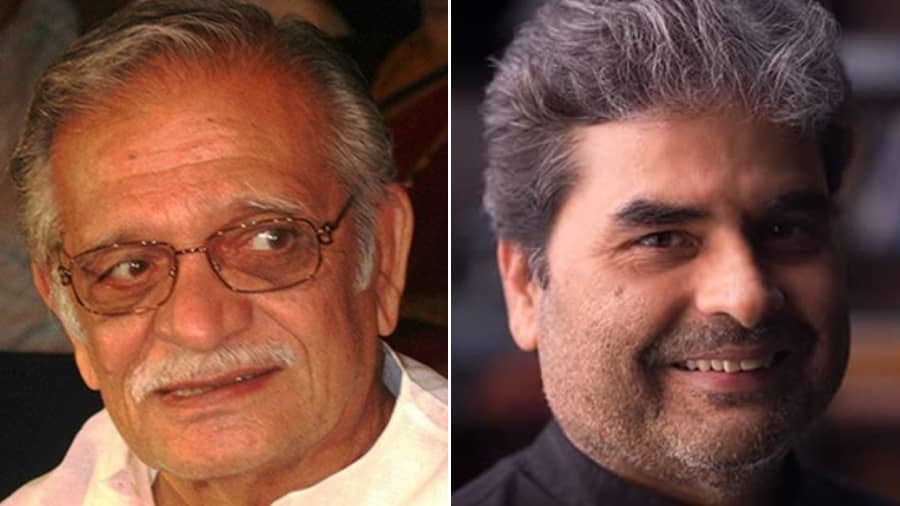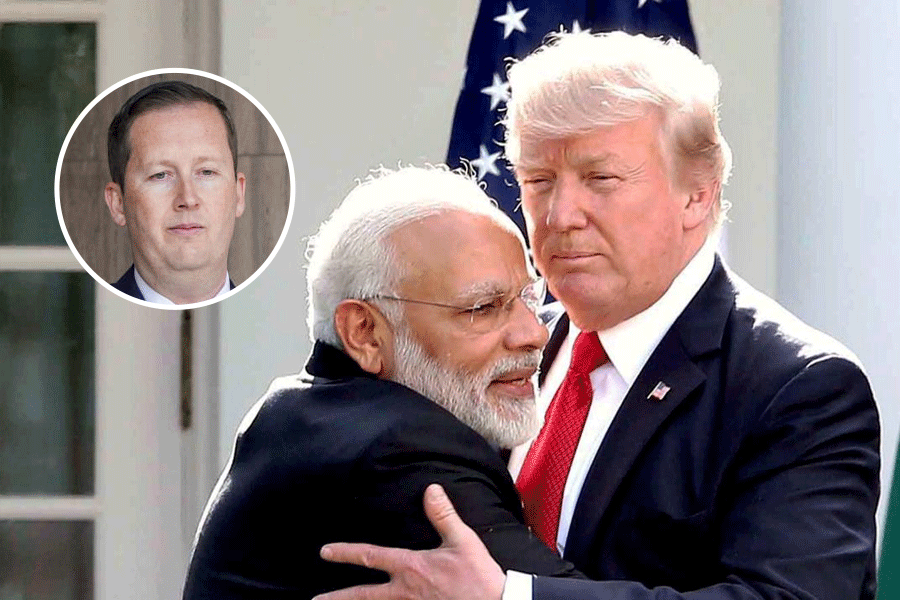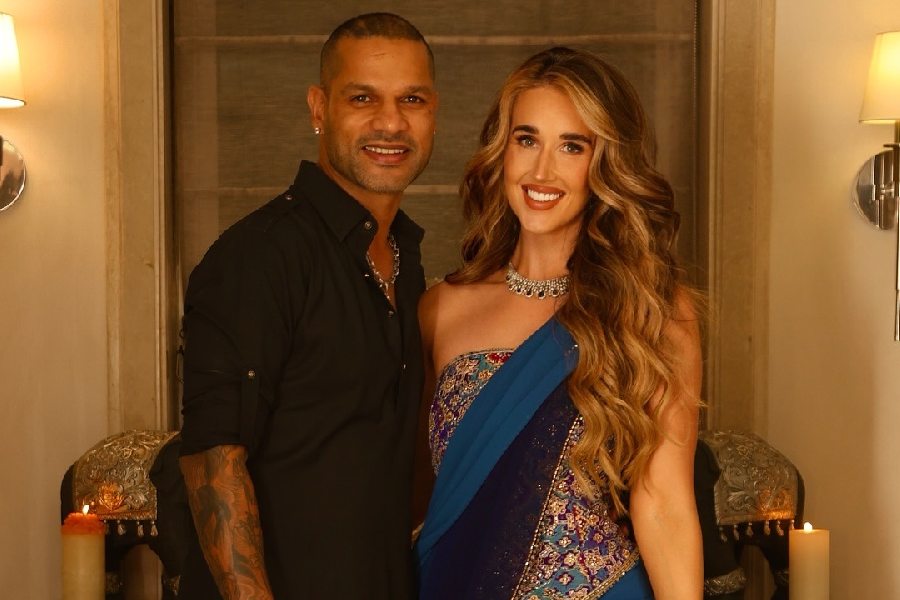Jungle jungle baat chali hai….
Chaddi pehen ke phool khila hai….
Two lines that have immortalised a rare jugalbandi on Indian screen – the one between Gulzar and Vishal Bhardwaj. The target audience? The young and the young at heart.
How did it all begin?
Vishal says, “Gulzar sa’ab was part of a creative committee at the Children’s Film Society (CFS) when Jaya Bachchan was the chairperson. The CFS was importing a lot of content at the time. We used to sit down every fortnight to record a song. It was quite an enjoyable experience. The visuals were given. We had to create around that. They could not be re-edited. We could only redub. I used to watch the visuals, muting the sound, latch on to the tempo and put it on the metronome. It was a challenge to create an original song in the same tempo for existing visuals.”
These TV gigs include the alliterative ‘Tap tap topi topi’ with phrases like ‘ulat-palat galat-salat taain’ and ‘ghugli jhinak jhaain’ in Alice in Wonderland (Vishal would use the refrain again in the song ‘Tippa’ in Rangoon). Or the title song of Sindbad Jahaazi, ‘Agar magar doley naiyya’, the title song of Guchhe (‘Kahani le lo’) and the cute dinosaur in Dana Danasur, recreated from Denver: The Last Dinosaur, with Gulzar giving the dinosaur a lovable spin of his own as ‘Danasur’, ‘chhipkali ka naana, chhipkali ka sasur’, likening its shape to musical instruments, a tanpura and a manjira.
“As a society we are insensitive towards our kids,” says Vishal. “We don’t make original content. Only a handful of people, like Gulzar sa’ab, devote themselves to creating for children. He has kept the child in him alive. It is such a beautiful thing. He is so evolved and at the same time so young at heart. It is remarkable how the three dimensions – the past, present and future – run parallel in him. He speaks in their language.”
Jungle jungle baat chali hai (The Jungle Book)
Among the first of the Gulzar-Vishal collaborations, this is the most enduring of them all when it comes to their work for children. Only Gulzar could have conjured up the ‘chaddi’ in a song and make it so evocative. He confides that officials in the Children Film Society had some issues with the word in a song for children and suggested he replace it with something like a lungi till Jaya Bhaduri put her foot down.
“Somebody else was supposed to do the song,” recounts Vishal. “But the composer did not have the time. The song had to be recorded in two days. I had worked with Gulzar sa’ab on the TV series Daane Anaar Ke (the title track ‘Kissa hai kahani hai paheli hai’). There were no mobile phones those days. I had an arrangement with an STD communication centre which would keep a log of any calls that came for me. I checked with him three-four times a day. One day, he told me that there was a call from Gulzar sa’ab. I still remember the number – 6461500. I called him and he asked me over to his house.
“There was a song that we had to work on and record the day-after. I went over. He asked me to play him a tune. I had composed almost all his poems in a book. One poem had the words ‘Gussa gussa gussa’ – he had personified anger in it. There was another that personified sorrow. I hummed the one I had composed for Gussa. And he loved it. In 30 minutes we had cracked… Chaddi pehen ke…. The rest is history. Even now, I keep coming across people in their forties who say how much the song was part of their childhood.”
O Papa, Billu aur Pillu
This was the Hindi version of Tom and Jerry, not the TV series, but Tom and Jerry: The Film, directed by Phil Roman. The story traces the adventures of an eight-year-old girl who is looking for her father. Pavan Jha, a veritable encyclopaedia on Gulzar, who also hosts a dedicated website on the poet, says, “The film had songs like Ek sikandar pahle tha; Hum to pakke gunday hain; and the title song Bil bil billu ki pillu se ladaai.” But the one that both Vishal and Gulzar bring my attention to is O Papa. Vishal says, “Normally, children’s songs tend to have a maternal connect. But here the situation provided Gulzar sa’ab the opportunity to come up with a heartfelt song that speaks about a daughter missing her father.” The imagery is vintage Gulzar:
Papa, hum rainbow pe jhumenge
Papa, aaj hum chaand choomenge
….
Laal book mein aapki hidayate
Neeli copy mein meri shikayate
Papa, aao ab hisaab do
Panga and Chhutii (Makdee)
For his debut directorial venture – something that too came about following Gulzar’s advice that if he wanted to make his kind of music in the industry, he had to make his kind of films – Vishal chose a film for children. Gulzar wrote the songs. In Panga, he nails the world of the feisty young protagonist with words that others may not even imagine in a song for children: O paapad wale, panga na le / thappad bajega.
Like R.D. Burman, Vishal too brings his own sensibilities to his compositions for children. Gulzar says, “If in Lakdi ki kaathi, the phrase tak-bak tak-bak is quintessentially Pancham and his Bangla roots, with Vishal, it is the same. Look at how he incorporates taun taun in Panga. It comes from his lived experience.”
Vishal laughs at the memory. “One thing I have realised working with Gulzar sa’ab is that, apart from keeping your inner child alive, for something to work for children there has to be something out-of-the-box compositionally too, some hook, something almost nonsensical, for want of a better word. The taun taun that Gulzar sa’ab mentions is something I created from my memory – how as kids we would tease our friends using that phrase. And he caught on to that and led from it. Similarly, for Chhutti, you might remember wedding bands playing a certain tune – I hummed it to him with the phrase Kisi pipdi mein kela bandmaster. It was very catchy and it became the refrain around which he draped the words, Hai kitabon se kutti, chhuti hai. You have to find the connect with children. It is not something you can design, it comes spontaneously.”
This idiosyncratic element is apparent in the way Makdee is shot and the children are portrayed. It led Vishal to part ways with the Children’s Film Society which was initially supposed to produce the film. Refusing to spoon-feed children, he decided to produce the film himself, becoming only the second composer in the industry after Salil Chowdhury to produce films. “I refuse to treat kids like idiots. In Makdee, children are treated as mature people,” he said in an interview at the time of the film’s release. No wonder that in Gulzar he found his soulmate.
The other song in the film, ‘Chhutti’, celebrates the joy of a holiday, throwing away books, and a school-going child’s perennial wish for a day off. Gulzar’s words capture the world of a child finding any reason to stay away from school. Note how he brings the entire week into the child’s ambit, culminating with the impish line ‘Monday ko Sunday ki chhutti hai’.
Asmani Chhatri and Tesoo (The Blue Umbrella)
Vishal returned to the genre and the world of children with his adaptation of Ruskin Bond’s story. Asmani chhatri is a child’s loving ode to her beautiful blue umbrella – notice how ingeniously Gulzar describes it, ‘ambar ka tukda toda, lakdi ka hatta joda, haath mein apna asmaan hai’, slicing off a piece of the sky, sticking a wedge of wood to it, carrying a fragment of heaven in her hand, likening the umbrella to a udan khatola, its swaying in the breeze to a hindola, a swing. Speaking to me, Gulzar underlines the word ‘hatta’. “It is a very culture-specific word. A lathi or danda would not do here.” Close your eyes and listen to the words. You can’t help marvel at the personification of an umbrella. Vishal’s compositional acumen – the refrain kukuri kukiri ku – adds to the song’s hummability quotient.
In the film’s other song, Tesoo, the poet and the composer bring to life a childhood memory, providing, in the words of Pavan Jha, a bridge between the old and the new. The Tesoo-Jhanjhi legend from the Mahabharata is popular in parts of north India, particularly the region stretching from Braj to Bundelkhand. Not so long ago, during the five-day period leading from Dussehra to Sharad Purnima, children went around collecting donations with a Tesoo-Jhanjhi effigy, singing the lines: ‘Tesoo agar kare, Tesoo magar kare… dahi badey mein banni, laao seth athanni.’
And in a fashion we have come to expect of Gulzar, he goes on to create a string of surreal images, reminiscent of Sukumar Ray: ‘Mendhak bole khari khari, naayi ki muchhe hari hari, gaay ki puchh pe dhaan uga, gaay ne kisi ki muchh chari, abhi muchh badi ki naayi bada’. Again, try to translate this for sense. But seen through the eyes of a child, the imagery is irresistible.
Shantanu Ray Chaudhuri is a film and music buff, editor, publisher, film critic and writer.










